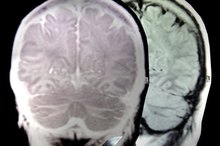Supratentorial White Matter Disease
Supratentorial white matter disease is a serious concern 2.
Its effects can lead to permanent disability, and doctors are still learning about the disease. What they know is that it is preventable for those who take necessary precautions. It is more common among the elderly, whose bodies have been subjected to more risk factors that led to supratentorial white matter disease, but the condition is often rooted in activities that occur relatively early in life 2.
Background
The supratentorial region of the human brain is located above the tentorium cerebelli.
This area features the cerebrum, a part of the brain located at the front of the cranium.
The cerebrum is the largest part of the brain. It makes up 85 percent of the brain's weight.
The cerebrum controls your voluntary movement and performs most of your thinking. It is involved in problem-solving and helps you to make decisions. The cerebrum contains both white matter and gray matter 2.
- The supratentorial region of the human brain is located above the tentorium cerebelli.
- The cerebrum is the largest part of the brain.
Function
What Is Ganglionopathy Sensory Neuropathy?
Learn More
About 40 percent of the brain consists of white matter, which contains nerve fibers called neurons that transmit pulses in the brain 2. The remainder is gray matter.
The white matter is the avenue for communication between multiple gray matter sections and between gray matter and other parts of the body's central nervous system 2. Think of the gray matter as a computer's CPU, and think of white matter as the circuit board through which the CPU does its work by connecting it with other parts of the computer 2.
Features
Without healthy white matter, the brain cannot function in a proper manner 2. White matter disease occurs when lesions appear in the white matter 2. Various conditions can cause these lesions. For example, lesions in the brain cause multiple sclerosis. Most occur in the white matter 2.
The lesions disrupt blood supply and clog pathways in the brain. This reduces the brain's ability to transmit information, because the white matter is less able to carry the communication signals of the gray matter 12.
In addition to affecting a person's ability to think clearly and make decisions, white matter disease also causes dysfunction that affects motor abilities and bodily functions 2. It affects balance, hampers a person's ability to walk by affecting gait and leads to incontinence in many cases.
- Without healthy white matter, the brain cannot function in a proper manner 2.
- In addition to affecting a person's ability to think clearly and make decisions, white matter disease also causes dysfunction that affects motor abilities and bodily functions 2.
Significance
Protein, Ammonia & Brain Damage
Learn More
White matter disease is a chronic condition 2.
When lesions appear, the pathways are interrupted, and this results in an inability to pass directions to the body's central nervous system from the gray matter. The result is an inability to think in general and difficulty making decisions.
In some cases, thought processes are slowed as gray matter searches for a pathway that is not damaged. If the number of lesions increases, symptoms also increase. Over time, a person's ability to solve problems and perform routine tasks can be completely stopped.
- White matter disease is a chronic condition 2.
- In some cases, thought processes are slowed as gray matter searches for a pathway that is not damaged.
History
According to Dr. Sandra Black, a Toronto neurologist, doctors first learned of abnormalities in the cerebrum's white matter when CT scans became common 2. Around 2000, a new brain scan technique called diffusion tensor imaging allowed doctors a closer look at the extent and cause of the damage.
Prevention
Doctors diagnose white matter disease using CT scans or MRI scans of the brain 2. These scans show abnormalities in the brain. According to Black, lesions in the white matter of the brain can be prevented 2. She said the recommended approach to preventing white matter disease is similar to that which helps you avoid heart attack and stroke 2. Black says you should keep blood pressure and cholesterol at healthy levels, avoid smoking, exercise regularly and eat a healthy diet.
Individuals with diabetes are at increased risk of white matter disease because they struggle with balancing their blood sugar, said Black 2.
She noted that the best approach is to adopt a healthy lifestyle at a young age. "You give yourself a better chance," said Black.
- Doctors diagnose white matter disease using CT scans or MRI scans of the brain 2.
- She noted that the best approach is to adopt a healthy lifestyle at a young age. "
Related Articles
References
- Cerebrum Information
- White Matter Explanation
- National Institutes of Health, U.S. National Library of Medicine: MedlinePlus. White Matter of the Brain. Updated September 16, 2020.
- Silbert LC, Dodge HH, Perkins LG, et al. Trajectory of white matter hyperintensity burden preceding mild cognitive impairment. Neurology. 2012;79(8):741-747. doi:10.1212/WNL.0b013e3182661f2b
- Filley CM. White matter dementia. Ther Adv Neurol Disord. 2012;5(5):267-277. doi:10.1177/1756285612454323
- University of California Davis Health System, Department of Neurology. White Matter Matters.
- Voss MW, Heo S, Prakash RS, et al. The influence of aerobic fitness on cerebral white matter integrity and cognitive function in older adults: results of a one-year exercise intervention. Hum Brain Mapp. 2013;34(11):2972–2985. doi:10.1002/hbm.22119
- Svatkova A, Mandl RC, Scheewe TW, Cahn W, Kahn RS, Hulshoff Pol HE. Physical Exercise Keeps the Brain Connected: Biking Increases White Matter Integrity in Patients With Schizophrenia and Healthy Controls. Schizophr Bull. 2015;41(4):869–878. doi:10.1093/schbul/sbv033
- Posner MI, Tang Y-Y, Lynch G. Mechanisms of White Matter Change Induced By Meditation Training. Frontiers in Psychology. 2014;5:1220. doi:10.3389/fpsyg.2014.01220.
- National Institutes of Health, U.S. National Library of Medicine: Medline Plus. Gray and White Matter of the Brain. February 27, 2013.
- VU University Amsterdam. Center for Children with White Matter Disorders.
Writer Bio
Based in Central Florida, Ron White has worked as professional journalist since 2001. He specializes in sports and business. White started his career as a sportswriter and later worked as associate editor for Maintenance Sales News and as the assistant editor for "The Observer," a daily newspaper based in New Smyrna Beach, Fla. White has written more than 2,000 news and sports stories for newspapers and websites. He holds a Bachelor of Arts degree in journalism from Eastern Illinois University.









